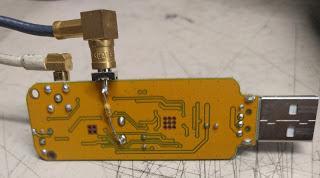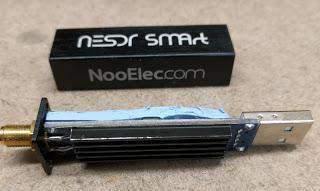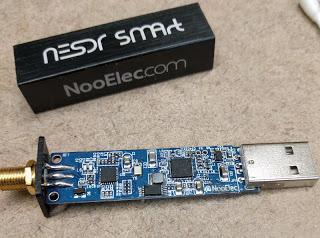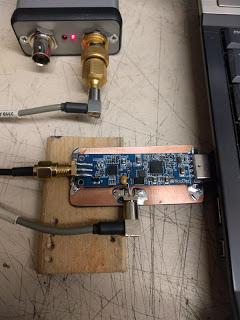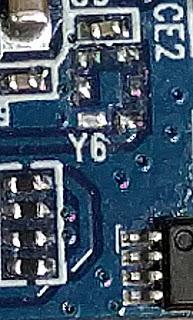Using an RTL 820 SDR "dongle" on 2m/70/23 cm WSPR
98 views
Skip to first unread message
n6gn
Mar 25, 2017, 4:28:09 PM3/25/17
to 2 Meter WSPR
A number of stations are having success with the very inexpensive RTL820 SDR dongles on VHF-and-up WSPR. At less than $25, along with a computer, they may be about the cheapest way to accomplish 12m - 23cm WSPR. The TCXO version is pretty stable and with care and a little additional thermal management probably can decode WSPR as high as 1296 MHz. WINSWL has had pretty good success running one this way. In addition to that station, N3IZN, WB7ABP and W6SFH are others who have or are now running this kind of set up.
Recently I tried adding a Bodnar reference to see if I could achieve accurate and completely stable 70cm WSPR spots with an old, non-TCXO RTL I had on the shelf. It turned out to be quite easy and works well. N6GN/d has been reporting into the database from one and appears to give about the same S/N reports as the homebrew transverter/Apache arrangement I normally run on 70cm WSPR.
To use the Bodnar as an external frequency reference/clock for the dongle, all I did was to set an output to 28.800000 MHz which is the dongle's nominal quartz oscillator's frequency. To shut off the stock oscillator and use only the external source all I did was mount an SMB connector onto the dongle edge, soldering it's ground pins to the ground plane of the dongle's circuit board, and coupled the center pin to the gate-input, P9, of the RT820 chip with a 390 pf axial leaded capacitor. I made the chip-end connection at the pin of the 28.8 crystal which I left in place. Doing it this way let the dongle run normally until a cable is connected. Connecting a 50 ohm cable coming from the Bodnar swamps the normal oscillation and injects external 28.8 into the chip. I didn't look with a scope to see what the level ended up as but 2V p-p is probably a good target. I left the Bodnar set at 16mA output.
Having done this, I checked to see that the dongle still worked with the SDR, HDSDR in my case. Everything seemed normal except with initial LO/Tune settings, the unit was not exactly tuned to 432.300000. I think that the Windows 10 DLL for the dongle, I used v2014.2, does not precisely set LO. In fact, it looked to me like the LO actually stepped in approximately 110 Hz steps and the TUNE setting (DSP after the RT820 Tuner) was possibly fudged in software to improve accuracy, or maybe it's not. To fix the accuracy I played with LO/TUNE values in HDSDR until I found one that properly set the frequency. The combination that worked for me was LO=431.720000 MHz and TUNE=432.300000. This appears to put 70cm spots within .2 Hz of correct.
If the dongle is used on other VHF/UHF bands probably other LO/TUNE settings will need to be discovered. I haven't done this yet but I think it is likely that there will be solutions that give correct calibration when TUNE is set to the WSPR dial settings for the bands.
It seems likely that the 2nd output of a Bodnar GPSDO might be used as the upconversion LO in place of the on-board quartz oscillator module in any of the common dongle upconverters. This should produce the ability for a dongle, upconverter and Bodnar to give better than 1 Hz accuracy on all WSPR bands from LF through 1296 MHz. Since CAT also works with HDSDR (and SDR# too, anyone know) a very inexpensive, fully GPS referenced band-hopping WSPR station for all ham bands through 23 cm should be easy to build at a very modest price.
I should add that I haven't yet verified the ultimate noise figure of the dongle's tuner. My first look showed something like an 8 dB noise figure, which isn't good and would indicate the need for a preamp. However at N6GN the antenna noise/temperature is already higher than that so adding a quiet preamp doesn't help reported S/N. A preamp might allow turning down the internal RF or IF gains in the dongle (settable from the DLL control panel) such that spurious dongle responses are reduced.
This is not a perfect receive solution and with the 8 bit ADC it has limitations but it's hard to imagine an accurate, capable all-band WSPR receive solution much less expensive than this.
Perhaps this sort of arrangement might be useful if we find the KH6HME beacon increasing 70cm interest among stations not currently on the band/mode. By referencing the receive end to the same (GPS) reference as the beacon, we effectively create a bi-static radar, a two port vector network analyzer, with which to examine the HI <---> Mainland path. If further examination continues to support the evidence that path characteristics can be better understood by watching Doppler shift, we may discover a better prediction method than currently exists. WSPR might point to when/where to operate to lengthen the current world terrestrial DX records on all the VHF-and-up amateur bands.
I've attached a screen shot of the GPS-referenced dongle running on 70cm into WSJT-X. Other than an antenna and USB connections to the dongle and an Ethernet connection to the Internet no additional hardware, cables, soundcards etc are required.
Glenn n6gn
Message has been deleted
Glenn Elmore
Mar 30, 2017, 12:12:14 AM3/30/17
to 2-mete...@googlegroups.com
Here are some pictures of
two RTL dongles, modified for use with the Bodnar GPSDO.
The blue dongle is the
non-tcxo version. I recommend it for this use instead of the TCXO
version because, like commercial transceivers, the efforts to make
it "high stability" are inadequate for GPS referenced UHF WSPR use
and also make it harder to modify to be useful this way.
The Black dongle is the
TCXO version. On it I had to use a hot air soldering station to
remove the unwanted TCXO. It also had a heat sink and some
thermal sticky padding I had to take off and clean up. The
pictures show before and after this was done.
It came in an aluminum
extrusion case and at first glance might seem to be better
shielded. I think it probably is not. For one thing, the grounds
of the board never make contact to the shield. For another, the
SMA connector isn't even secured to the shield, there is a nut but
it doesn't do anything useful.
Upon seeing this, my
solution was to take it apart, discard the extrusion and solder
the whole works to a small piece of 1/16" double clad PC board.
If you do this, be sure to snip of the USB connections since the
leads are a bit long and might otherwise short. I soldered at the
SMA end and at the USB end. I also soldered the SMB connector for
the Bodnar LO injection. Other than the removal of the case and
the TCXO this is essentially the same as the blue, less expensive
dongle.
A sharp eyed viewer may
notice that the modified blue dongle doesn't actually have the LO
injected where I said, it's on the end of the crystal going to the
driving gate rather than on the input. It probably will work
either way. The way I did it the 50 ohm output from the Bodnar
fights with the gate output but the injected signal does also get
filtered by the crystal.
Reply all
Reply to author
Forward
0 new messages




